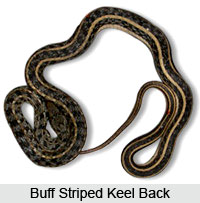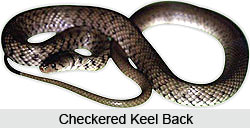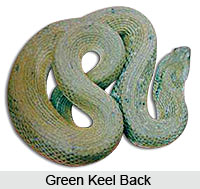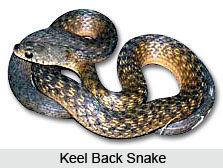 There are different types of keel backs. They are checkered keel backs, blue stripped keel back, Oliv Aceous Keelback, Green Keelback. The keel backs live in both fresh water and fields.
There are different types of keel backs. They are checkered keel backs, blue stripped keel back, Oliv Aceous Keelback, Green Keelback. The keel backs live in both fresh water and fields.
Checkered Keelback (Xenochrophis piscator )
Local Names: Hindi Pani ka samp, Dhoria; Oriya Pani dhanda; Assamese Dhora; Gujarati Dendu; Bengali Jal dhonra; Marathi Virola, Pan chidda, Divad; Kanarese Neeru havu, Holay havu, Haramandalatha havu; Malayalam Neer kolee, Tamil Thaneer pamboo.
The species name of the Checkered Keelback is piscator. It is a harmless variety of snake and is a fairly robust snake with oval head having slit-like nostrils and moderately large eyes. Its tail is one-third to one-fourth of its total length.
Four races of this snake are recognized. Xenochrophis piscator piscator has strong-keeled scales and five rows of black spots on its yellowish or olivaceous background. The spots vary in size sometimes occupying most of the back. Its head is olive brown with two black streaks one below and one behind eye. Its belly is white or yellowish in color. The ground color of this snake may be dull green, olive-brown or brown of almost any shade, light or dark. Apart from the black markings some are spotted or blotched with red varying in intensity from salmon or rose pink to a brilliant scarlet.
Keel Backs (that live in fresh water)
 The Keel Backs are the commonest freshwater snakes. This snake is found in tanks, paddy fields, pools and rivers. This snake is the cruelest among Indian snakes with the exception of the Echis. This snake strikes rapidly with great determination holding on tenaciously. Prior to striking it flattens its fore body. It is an extremely active snake, capable of jumping clear off the ground and will do so repeatedly if pursued. Inside water it swims with vigor. This snake is a versatile diver. This snake feeds mainly on frogs, fish and tadpoles. The female is longer in length than the males but has a shorter tail. The male and female stay together for a considerable time, even after the female is egg bound. . The period of gestation is 55 to 67 days. The female probably incubates the eggs. The eggs are usually laid in a nest hole in the ground near water.
The Keel Backs are the commonest freshwater snakes. This snake is found in tanks, paddy fields, pools and rivers. This snake is the cruelest among Indian snakes with the exception of the Echis. This snake strikes rapidly with great determination holding on tenaciously. Prior to striking it flattens its fore body. It is an extremely active snake, capable of jumping clear off the ground and will do so repeatedly if pursued. Inside water it swims with vigor. This snake is a versatile diver. This snake feeds mainly on frogs, fish and tadpoles. The female is longer in length than the males but has a shorter tail. The male and female stay together for a considerable time, even after the female is egg bound. . The period of gestation is 55 to 67 days. The female probably incubates the eggs. The eggs are usually laid in a nest hole in the ground near water.
Keel Backs(living in fields)
The keelbacks living in fields are gentle little snakes. They live in fields on grassy and cultivated areas of open country during the rains. The snake usually hides in holes in the ground or in masonry of drains. When alarmed the snake flattens its neck and fore body and distend themselves by deep inhalation bringing into view the beautiful blue or vermilion on the base of the scales. This snake appears abundantly during the rainy season. It feeds on frogs and toads.
The mating season is during aestivation. They lay eggs in any convenient refuge underground. Usually the females remain with the eggs. Eggs that are pure white in color form a cluster when laid. The young double their length by the first year of life and treble it by the second year. The mating season is during aestivation. They lay eggs in any convenient refuge underground. Usually the females remain with the eggs. Eggs that are pure white in color form a cluster when laid. The young double their length by the first year of life and treble it by the second year.
Buffstriped Keel Back (Amphiesma stolata)
Local Names: Bengali Hele sap; Marathi Naneti; Telugu Wannapam; Tamil
Nirkatanpambu.
 The species name of the Buffstriped Keel Snake is stolata. It`s a graceful little snake with a short body and long tail which is approximately a quarter of the total length. Its neck is evident and its eyes are large, pupil round, flecked with gold. Its tongue is dull orange and tip of the tongue is black. Its ground color is olivaceous-brown. Its head is olivaceous-brown, whitish, yellowish or orange on lips. There are different shades on this snake. Its chin and throat vary in color between white, yellow or orange. Its belly is white with some small-scattered black spots.
The species name of the Buffstriped Keel Snake is stolata. It`s a graceful little snake with a short body and long tail which is approximately a quarter of the total length. Its neck is evident and its eyes are large, pupil round, flecked with gold. Its tongue is dull orange and tip of the tongue is black. Its ground color is olivaceous-brown. Its head is olivaceous-brown, whitish, yellowish or orange on lips. There are different shades on this snake. Its chin and throat vary in color between white, yellow or orange. Its belly is white with some small-scattered black spots.
There are two distinct color varieties of this snake.
· In one variety the overlapping margins of scales are blue-grey or pale blue.
· In the other variety bright vermilion replaces the blue color.
These colors are very evident when the snake inflates its body under excitement. The females are longer than the males.
Oliv Aceous Keelback (Atretium schistosum)
Local Names: Telugu Na/la wahlagillee pam, Kanarese Barmmya.
The species name of the Oliv Aceous Keelback is schistosum. This snake is a fairly robust small snake with a short snout and small slit-like nostrils placed rather high as in water snakes. Its tail is long and measures one fourth to one-third of the total length. Its color is uniform deep olive-green above and uniform yellow of varying intensity below and is sometimes tinged with pink or lilac on the flanks. Its lips are yellow or pinkish.
 The Oliv Aceous Keelback lives usually near water or among the surrounding vegetation. It is largely diurnal and feeds mainly on frogs, fish and crabs. It aestivates in hot weather. It breeds during the rainy season and eggs are laid from January to April. It usually lays T 10 to 32 eggs. They are usually white, soft and 30 to 35 mm in length.
The Oliv Aceous Keelback lives usually near water or among the surrounding vegetation. It is largely diurnal and feeds mainly on frogs, fish and crabs. It aestivates in hot weather. It breeds during the rainy season and eggs are laid from January to April. It usually lays T 10 to 32 eggs. They are usually white, soft and 30 to 35 mm in length.
Green Keelback (Macropisthodon plumbicolor)
Local Names. Tamil Pachai nagam; Marathi Hara samp, Gavathia, Gautya
sap.
The species name of the Green Keelback is plumbicolor. It is somewhat similar to the green pit vipers. The shield on the head of the Green Keelback distinguishes it from the green pit vipers. This snake is small and stout. Its eyes are moderately large and are greenish gold in color. A yellow pigment overlying the bluish scales produces the green color in this species. Its tail is short and is only one-seventh to one-ninth total length. The adults are grass green on the top with a few black spots, which may show a tendency to form transverse bars. The young ones have a well-defined black chevron on the nape with its angle pointed forwards. Following the chevron is a broad gorget of bright yellow or orange. There is a black streak from eye to gape.
The snake is found in the hills and it favors altitudes between 600-1800 m.
This snake is gentle and inoffensive and erects its fore body and flattens its neck like a cobra, hence the name `green cobra`. Though often seen in grass and scrub during daytime it restricts its movements to the night. It aestivates during the summer. It feeds on toads and lizards. The secretion of the large parotid glands is toxic to frogs and toads.











